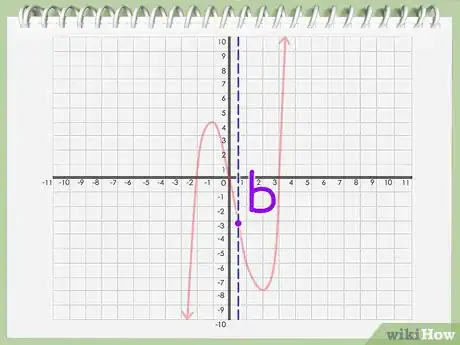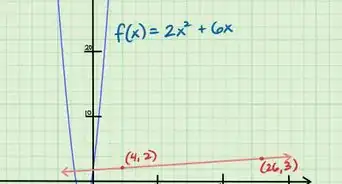wikiHow is a “wiki,” similar to Wikipedia, which means that many of our articles are co-written by multiple authors. To create this article, volunteer authors worked to edit and improve it over time.
This article has been viewed 92,967 times.
Learn more...
The graph of a polynomial or function reveals many characteristics that would not be clear without a visual representation. One of these characteristics is the axis of symmetry: a vertical line on a graph that splits the graph into two symmetrical mirror images. Finding the axis of symmetry for a given polynomial is fairly simple.[1] There are two basic methods.
Steps
Finding the Axis of Symmetry for Polynomials with a Degree of 2
-
1Check the degree of your polynomial. The degree (or “order”) of a polynomial is simply the largest exponent value in the expression.[2] If the degree of your polynomial is 2 (there is no exponent larger than x2), you can find the axis of symmetry using this method. If the degree of the polynomial is higher than 2, use Method 2.
- To illustrate, take, as an example, the polynomial 2x2 + 3x – 1. This highest exponent present is the x2, so it is a 2nd order polynomial, and you can use this first method to find the axis of symmetry.
-
2Plug your numbers into the axis of symmetry formula. To calculate the axis of symmetry for a 2nd order polynomial in the form ax2 + bx +c (a parabola), use the basic formula x = -b / 2a.[3]
- In the example above, a = 2 b = 3, and c = -1. Insert these values into your formula, and you will get:
x = -3 / 2(2) = -3/4.
Advertisement - In the example above, a = 2 b = 3, and c = -1. Insert these values into your formula, and you will get:
-
3Write down the equation of the axis of symmetry. The value you calculated with your axis of symmetry formula is the x-intercept of the axis of symmetry.[4]
- In the example above, the axis of symmetry is -3/4.
Finding the Axis of Symmetry Graphically
-
1Check the degree of your polynomial. The degree (or “order”) of a polynomial is simply the largest exponent value in the expression. If the degree of your polynomial is 2 (there is no exponent larger than x2), you can find the axis of symmetry using the formula method above. If the degree of the polynomial is higher than 2, use this graphical method.
-
2Draw the x- and y- axes. Make two lines in the shape of a plus sign. The horizontal line is your x-axis; the vertical line is your y-axis.
-
3Number your graph. Mark both axes with numbers at equal intervals. Spacing should be uniform on both axes.
-
4Calculate y = f(x) for every x. Take your polynomial or function and calculate values of f(x) by putting all values of x into it.
-
5Make a graph point for each pair. You now have pairs of y = f(x) for every x on the axis. For each (x, y) pair, make a point on the graph – vertically on the x-axis and horizontally on the y-axis.
-
6Draw the graph of the polynomial. Once you have marked all the graph points, you can connect your dots smoothly to reveal a continuous graph of your polynomial.[5]
-
7Look for the axis of symmetry. Inspect your graph carefully. Look for a point on the axis such that when a line is passed through it, the graph splits into two equal, mirrored halves.[6]
-
8Note the axis of symmetry. If you can find a point – call it “b” – on the x-axis that splits the graph into two mirrored halves, then that point, b, is your axis of symmetry.[7]
Community Q&A
-
QuestionWhat is the axis of symmetry of f for f(x)=-2|x+3|-7?
 Community AnswerThe axis of symmetry is x=-3, because the vertex is at (-3,7). It is an absolute value graph that faces down.
Community AnswerThe axis of symmetry is x=-3, because the vertex is at (-3,7). It is an absolute value graph that faces down. -
QuestionWhat is the axis of symmetry in x = -2(x - 3) + 5?
 DonaganTop AnswererBecause this graph consists of a straight line, it does not have an axis of symmetry. Axes of symmetry occur with parabolic graphs representing quadratic equations ("second-degree" polynomials).
DonaganTop AnswererBecause this graph consists of a straight line, it does not have an axis of symmetry. Axes of symmetry occur with parabolic graphs representing quadratic equations ("second-degree" polynomials). -
QuestionWhat is the axis of symmetry of f(x) = -x^2 - 6x + 4?
 DonaganTop AnswererAs explained in the above article, the axis of symmetry of a second-degree polynomial in the form of ax² + bx + c is given by the formula x = -b/2a, which in this case is x = -(-6) / 2(1) = 6/2 = 3. x=3.
DonaganTop AnswererAs explained in the above article, the axis of symmetry of a second-degree polynomial in the form of ax² + bx + c is given by the formula x = -b/2a, which in this case is x = -(-6) / 2(1) = 6/2 = 3. x=3.
References
- ↑ https://www.purplemath.com/modules/symmetry3.htm
- ↑ https://www.mathsisfun.com/algebra/degree-expression.html
- ↑ https://virtualnerd.com/algebra-1/quadratic-equations-functions/graphing/graph-basics/axis-symmetry-example
- ↑ https://virtualnerd.com/algebra-1/quadratic-equations-functions/graphing/graph-basics/axis-symmetry-example
- ↑ https://www.learnalberta.ca/content/memg/Division04/Axis%20of%20Symmetry%20(Parabola)/index.html
- ↑ https://www.khanacademy.org/math/algebra2/polynomial-functions/introduction-to-symmetry-of-functions/v/recognizing-odd-and-even-functions
- ↑ https://www.learnalberta.ca/content/memg/Division04/Axis%20of%20Symmetry%20(Parabola)/index.html
About This Article
To find an axis of symmetry, start by checking the degree or largest exponential value of the polynomial. If the degree of your polynomial is 2, you can find the axis of symmetry by plugging the numbers directly into the axis of symmetry formula. Solve the formula and the answer you get is the x-intercept of the axis of symmetry. If the degree of the polynomial is higher than 2, you will need to find the axis of symmetry by using a graph. For tips on solving graphically, read on!





































































